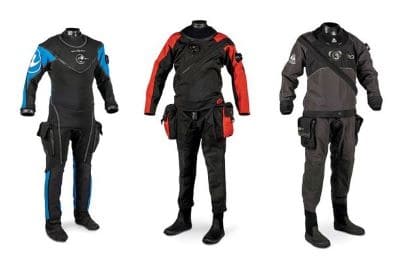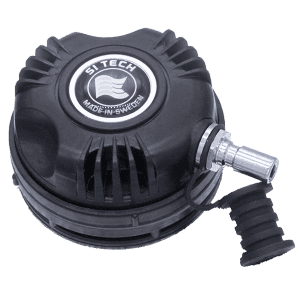Home › Diving › Equipment › Wetsuits › Drysuits
Dry Suits for Scuba Diving
Dry Suits provide maximum thermal protection. Although primarily used in cooler water, in temperate water they let you make more dives and longer dives even if you could use a wetsuit.
Dry Suits get their name because they keep you dry, except for (typically) your head and hands, over which you wear neoprene wetsuit hoods and gloves.
All dry suits cover the entire body.
Neoprene dry suits are made of the same material as wetsuits, except they exclude water. The neoprene provides insulation.
Shell dry suits consist of two pieces. The first is a shell suit, made of one of many materials (crushed neoprene, trilaminate, urethane, vulcanised rubber), that keeps you dry.
The second is the undergarment, also of several materials (bunting, open foam, ThinsulateTM), that provides the insulation. Suits used in the coldest water have dry hoods and dry gloves or mitts.
Drysuit Insulation
Dry suits provide more insulation for divers by keeping you dry. They offer the most thermal protection of all exposure suits and they make a noticeable difference in how long you can stay comfortable in underwater temperatures of around 18 degrees Celsius.
 They are the main option for all comfortable dives in water colder than 10 degrees Celsius.
They are the main option for all comfortable dives in water colder than 10 degrees Celsius.
Air conducts heat relatively poorly, so the dry suit insulates you with a layer of air. Divers often wear extra insulating material as an undergarment.
Unlike a wetsuit, everything between your skin and the water reduces heat loss. Also unlike wetsuits for scuba divers, they fit relatively loosely.
Note: Another section explains more about the medical considerations for drysuit divers, including how to avoid neck and wrist constriction with expert tips for managing dermatological skin rashes.
Exposure Suit Accessories
In cooler water - below about 21 degrees C - divers may also need exposure protection for their head, hands, and feet. Wearing additional neoprene garments also protects hands and feet from minor cuts and abrasions.
This extra protection comes from these three main exposure suit accessories.
Drysuit Tip - Be prepared to invest more than for a comparable wetsuit. However, dry suits last substantially longer (10 years or more is not unusual) and when you consider the additional dive time they give, they pay for themselves.
Drysuits FAQs
What is a Dry Suit?
Unlike traditional neoprene wetsuits, airtight immersion suits use a gas to insulate the wearer - instead of a thin layer of water.
But, because the pressure around scuba divers increases as they descend, the air space created by wearing a drysuit (the insulation layer) will shrink.
To avoid getting a 'squeeze' from this increased pressure, we need a mechanism for adding extra gas into the suit when we are underwater.
Here's the thing:
Pressing a dry suit chest valve (connected to a regulator via a low pressure inflator hose) will add gas to the insulation layer.
But, we also need a way to get rid of excess gas as we ascend to the surface. If the gas expands inside the suit it will make us more buoyant. That's why drysuits have 'dump valves'.
How Do Drysuit Cuff Dumps Function?
The two basic types of drysuit dump valves are the auto dumps and cuff dumps. Even though a cuff dump mechanism is a simple one way valve fitted to the left cuff. They are the least popular of the two, primarily because they are more 'manual' than the auto dumps.
Water pressure on the outside of a cuff valve keeps it in the closed position. However, if a large amount of gas travels to the cuff - it usually vents itself.
When a diver leans slightly to the right in the water, and raises their left hand, gas travels from the inside of the suit up the arm section and out through the valve near the wrist.
Important: A lack of high pressure at the surface means water can enter the cuff through an open valve and you will get a wet sleeve. Hence, you should keep your left arm above the water or below it while you are at the surface.
How Do Auto Shoulder Drysuits Work?
Auto dumps (also known as shoulder dumps) are available in various styles. The best location for this type of valve assembly is the left shoulder area on a dry suit (e.g. the highest point).
Keep in mind if you're learning how to become a dry suit diver specialist that you can adjust the resistance setting underwater. Thus, you can change when it vents gas by altering the sensitivity of the valve. For example:
- Manually dialing it into the strongest setting 'closes' the valve - and it should not vent at all. As a result, excessive inflation at the surface could make you look like you're wearing a sumo suit.
- When it's adjusted to the lightest setting, any gas that passes by will vent (e.g. like the cuff dump mechanism).
Note: You can set up the dial to vent as required. Hence, the main benefit of shoulder valves is having a choice for using the automatic venting process.
 How to Use the SI TECH Auto Dump Mechanism?
How to Use the SI TECH Auto Dump Mechanism?
One of the primary products that the Swedish company SI TECH AB makes are the inflation valves for dry suits.
In essence, there are two separate parts that use a simple screw to sandwich the suit material in the middle.
The inside section acts as a buffer that allows the gas to flow around the interior of the suit.
Plus, a filter helps to prevent the valve from clogging up (e.g. talcum powder, lint, or other contaminants).
The outside contains two (2) valves in the centre. There is a one-way safety valve (called a check valve) which allows air out and stops water from getting in.
The outer gasket acts as a sealing membrane. So, it determines when to vent (e.g. rotating the outer shell adjusts the sensitivity).
But wait - there's more:
What if you need to override the auto dump mechanism, such as in an emergency? During a dive, you can bypass the membrane by pushing the shell inwards. Doing so pushes the section that holds the membrane up against the sealing surface.
Note: Another section contains a list of medical concerns for drysuit divers, including how to use the pee valve drysuit function underwater.
Scuba Accessories |> Log Books |> Underwater Writing Slates |> Rescue Protective Barriers |